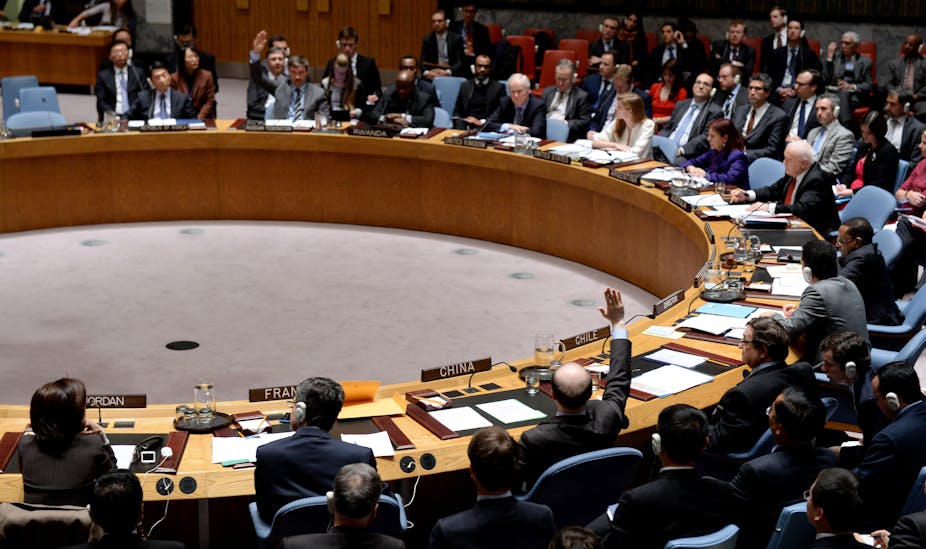On four occasions since the crisis in Syria erupted, Russia and China have vetoed draft resolutions put to the Security Council. In response, the Global Centre for R2P (GCR2P) has launched the “#restraintheveto” campaign, declaring that “it is incumbent upon the P5 not to veto a draft Security Council resolution aimed at halting the perpetration of mass atrocity crimes.”
Veto restraint was first proposed in the 2001 report The Responsibility to Protect, but won little support. At the 2005 World Summit, two paragraphs of the Outcome Document recognised a variant of the Responsibility to Protect (R2P), but no references were made to veto restraint.
Nonetheless, the idea has now been resurrected, and #restraintheveto is being retweeted, liked and shared – one of the most visible and fast-spreading social media campaigns in the UN’s history.
Of course, this does not mean the campaign makes any sense.
Get real
The notion that the Kremlin or the Chinese Communist party will be influenced by a multitude of tweets is laughable, and the actual influence of high-publicity social media campaigns on states is certainly chequered.
The cost-free engagement they attract has often proved to be highly superficial, most embarrassingly in the case of “Kony 2012”. But the problems go deeper than the questionable strategy: the campaign is also based on a misconception of why the veto is used in the first place.
Vetoes are used for one of two things: to block proposals in a draft resolution a power thinks are genuinely unsound, or for simply selfish reasons. Neither will be influenced by this proposal.
Russia and China, for instance, claim their vetoes are a function of their principled position on what will best restore peace, and they have never cited purely geopolitical motives. But whether or not one believes or agrees with them, the idea that these two P5 powers have repeatedly and publicly stood in the way of crucial measures out of pure realpolitik is highly simplistic.
A blanket call for automatic restraint, therefore, misses the fact that draft resolutions may well be ill-conceived to the point where they need to be vetoed. The call that all proposals framed as “aimed at halting the perpetration of mass atrocity crimes” should be supported is specious and potentially reckless; righteous aims do not justify misconceived or foolhardy means, which may do more harm than good.
Genuinely selfish geopoliticking, meanwhile, is even less likely to be curbed by veto restraint. If Russia has cast its various vetoes on Syrian issues simply because it has key strategic interests in protecting Assad’s regime, it makes no sense to demand that it change tack because of some larger principle. There is surely little to be gained from asking Russia to set aside what it deems its vital national interests after it has repeatedly demonstrated its determination to pursue them no matter the humanitarian cost.
Vetoes are not cast gratuitously. An examination of their use demonstrates they are employed when the vital national interests of the veto-wielding-power are deemed to be at stake. So by championing “restraint”, campaigners are actually calling for a revolution in the respective foreign policy priorities of the P5. That this can be realised is incredibly ambitious; that it can be impelled via Twitter and Facebook is arguably inconceivable.
Responsibility to what?
This campaign is also perpetuating a disturbingly pervasive misunderstanding of the P5’s position on R2P.
According to GCR2P Director Simon Adams, “The Responsibility to Protect, adopted at the 2005 World Summit…means that the five Permanent Members of the Security Council have a responsibility not to veto in a mass atrocity situation.”
But this is simply not true, since veto restraint isn’t mentioned anywhere in the R2P Outcome Document. The wording merely commits the P5 to act on “a case-by-case basis”, and therefore simply enshrines their discretionary powers – including the veto.
The GCR2P has heralded the fact that many states have endorsed the idea of voluntary restraint, yet the last sentence of the document detailing this support is the most telling: “Four additional states have spoken on the veto, but did not express support…China, Russia, United Kingdom and United States”. In other words, four of the P5 have expressly rejected the idea.
Syria has once again highlighted the influence of politics on law enforcement at the heart of the international system. This should surprise no-one. R2P, once vaunted as revolutionary, has simply affirmed the centrality of the Security Council and overlooked the idea of reforming it; the inertia over Syria is the result.
Yes, the veto is a problem – but to solve it we need to stop affirming the very system within which it exists. The purveyors of R2P must accept that it’s their own poorly articulated policy that has allowed the P5 to shore up their power. They also need to stop sponsoring distracting, hopeless campaigns and get behind actual reform.

